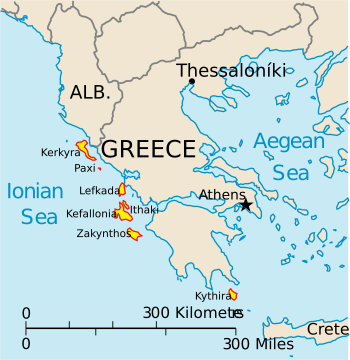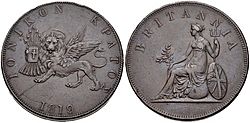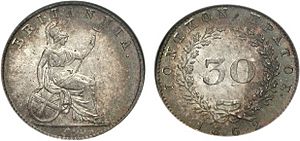United States of the Ionian Islands facts for kids
Quick facts for kids
United States of the Ionian Islands
|
|||||||||||
|---|---|---|---|---|---|---|---|---|---|---|---|
| 1815–1864 | |||||||||||
|
|
|||||||||||

The Republic's territory extended to the seven main islands plus the smaller islets of the Ionian Sea
|
|||||||||||
| Status | Amical protectorate of the United Kingdom of Great Britain and Ireland | ||||||||||
| Capital | Corfu | ||||||||||
| Official languages | Greek, English, Italian | ||||||||||
| Common languages | Venetian | ||||||||||
| Religion | Greek Orthodox | ||||||||||
| Government | Federal republic | ||||||||||
| Legislature | Parliament | ||||||||||
| Senate (executive) | |||||||||||
| Legislative Assembly | |||||||||||
| Historical era | 19th century | ||||||||||
|
• Congress of Vienna
|
9 June 1815 (signed) | ||||||||||
|
• Protectorate established
|
9 November 1815 | ||||||||||
|
• Constitution
|
26 August 1817 | ||||||||||
|
• Resolution for union with Greece
|
26 November 1850 | ||||||||||
| 29 March 1864 | |||||||||||
|
• Union with Greece
|
28 May 1864 | ||||||||||
| Area | |||||||||||
| 1864 | 4,696 km2 (1,813 sq mi) | ||||||||||
| Population | |||||||||||
|
• 1864
|
236,000 | ||||||||||
| Currency | Obol (1818–64) | ||||||||||
|
|||||||||||
| Today part of | Greece | ||||||||||
|
References: Capital city; languages.
|
|||||||||||
The United States of the Ionian Islands (Greek: Ἡνωμένον Κράτος τῶν Ἰονίων Νήσων, romanized: Inoménon-Krátos ton Ioníon Níson, lit. 'United State of the Ionian Islands'; Italian: Stati Uniti delle Isole Ionie) was a Greek state and amical protectorate of the United Kingdom between 1815 and 1864. The successor state of the Septinsular Republic, it covered the territory of the Ionian Islands, as well as the town of Parga on the adjacent mainland in modern Greece. It was ceded by the British to Greece as a gift to the newly enthroned King George I, apart from Parga, which was sold to Ali Pasha of Ioannina in 1819.
Contents
History
Before the French Revolutionary Wars, the Ionian Islands had been part of the Republic of Venice. When the 1797 Treaty of Campo Formio dissolved the Republic of Venice, they were annexed to the French Republic. Between 1798 and 1799, the French were driven out by a joint Russo-Ottoman force. The occupying forces founded the Septinsular Republic, which enjoyed relative independence under nominal Ottoman suzerainty and Russian control from 1800 until 1807.
The Ionian Islands were then occupied by the French after the treaty of Tilsit. In 1809, Britain defeated the French fleet off Zakynthos island on 2 October, and captured Kefalonia, Kythira, and Zakynthos. The British proceeded to capture Lefkada in 1810. The island of Corfu remained occupied by the French until 1814.
Under the Treaty between Great Britain and [Austria, Prussia and] Russia, respecting the Ionian Islands (signed in Paris on 5 November 1815), as one of the treaties signed during the Peace of Paris (1815), Britain obtained a protectorate over the Ionian Islands, and under Article VIII of the treaty the Austrian Empire was granted the same trading privileges with the Islands as Britain. As agreed in Article IV of the treaty a "New Constitutional Charter for the State" was drawn up and was formalised with the ratification of the "Maitland constitution" on 26 August 1817, which created a federation of the seven islands, with Lieutenant-General Sir Thomas Maitland its first "Lord High Commissioner of the Ionian Islands".
During this period, the British brought thousands of Maltese labourers to the Ionian Islands to work as builders and artisans, forming the basis of the Corfiot Maltese community.
A few years later Greek nationalist groups started to form. Although their energy in the early years was directed to supporting their fellow Greek revolutionaries in the revolution against the Ottoman Empire, they switched their focus to enosis with Greece following their independence. The Party of Radicals (Greek: Κόμμα των Ριζοσπαστών) founded in 1848 as a pro-enosis political party. In September 1848 there were skirmishes with the British garrison in Argostoli and Lixouri on Kefalonia, which led to a certain level relaxation in the enforcement of the protectorate's laws, and freedom of the press as well. The island's populace did not hide their growing demands for enosis, and newspapers on the islands frequently published articles criticising British policies in the protectorate. On 15 August in 1849, another rebellion broke out, which was quashed by Henry George Ward, who proceeded to temporarily impose martial law.
On 26 November 1850, the Radical MP John Detoratos Typaldos proposed in the Ionian parliament the resolution for the enosis of the Ionian Islands with Greece which was signed by Gerasimos Livadas, Nadalis Domeneginis, George Typaldos, Frangiskos Domeneginis, Ilias Zervos Iakovatos, Iosif Momferatos, Telemachus Paizis, Ioannis Typaldos, Aggelos Sigouros-Dessyllas, Christodoulos Tofanis. In 1862, the party split into two factions, the "United Radical Party" and the "Real Radical Party". During the period of British rule, William Ewart Gladstone visited the islands and recommended their reunion with Greece, to the chagrin of the British government.
On 29 March 1864, representatives of Great Britain, Greece, France, and Russia signed the Treaty of London, pledging the transfer of sovereignty to Greece upon ratification; this was meant to bolster the reign of the newly installed King George I of Greece. Thus, on 28 May, by proclamation of the Lord High Commissioner, the Ionian Islands were united with Greece.
Languages
According to the second constitution of the Republic (1803), Greek was the primary official language, in contrast to the situation in the Septinsular Republic. Italian was still in use, though, mainly for official purposes since the Venetian Republic. The only island in which Italian (Venetian) had a wider spread was Cephalonia, where a great number of people had adopted Venetian Italian as their first language.
States
The United States of the Ionian Islands was a federation. It included seven island states, each of which was allocated a number of seats in the parliament, the Ionian Senate:
| State | Capital | Members elected |
|---|---|---|
| Corfu | Corfu | 7 |
| Cephalonia | Argostoli | 7 |
| Cythera | Kythira | 1 or 2 |
| Ithaca | Vathy | 1 or 2 |
| Paxos | Gaios | 1 or 2 |
| Leucas | Lefkada | 4 |
| Zakynthos | Zakynthos | 7 |
Government
The British organised administration under the direction of a Lord High Commissioner, appointed by the British government. In total, ten men served in this capacity, including William Gladstone as a Lord High Commissioner Extraordinary (in office 1858–1859).
The Ionian Islands had a bicameral legislature, titled the "Parliament of the United States of the Ionian Islands" and composed of a Legislative Assembly and Senate.
The 1818 constitution also established a High Court of Appeal to be called the Supreme Council of Justice of the United States of the Ionian Islands, of which the president was to be known as the Chief Justice, who would rank in precedence immediately after the President of the Senate.
The successive Chief Justices were:
- John Kirkpatrick 1820–1835
- Sir James John Reid 1837–?
- Sir Charles Sargent 1860–?
- Sir Patrick MacChombaich de Colquhoun 1861–1864
See also
- List of Greek countries and regions
- List of Lord High Commissioners of the Ionian Islands
- Order of St Michael and St George, a British order of chivalry created in honour of the protectorate.





